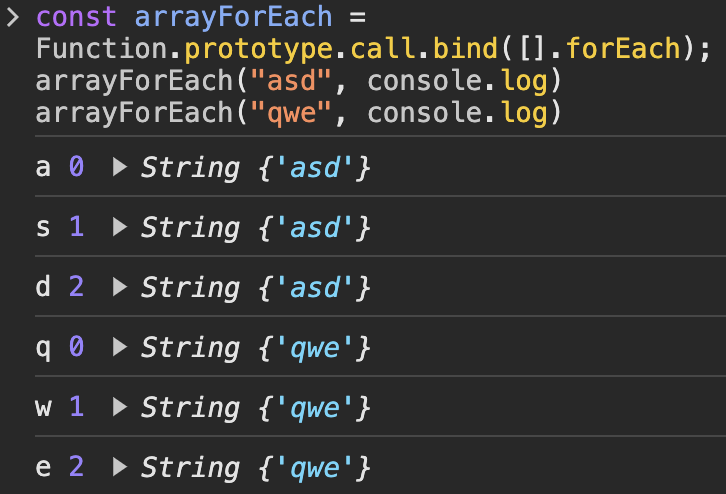Top-level Array generics didn’t make it into EcmaScript. Here’s how to hand-roll them.
const myFilter = Function.prototype.call.bind(Array.prototype.filter);
Code language: JavaScript (javascript)And that gives is a function that can be called as:—
const isNotUpper = e=>e>"Z"; // lexicographic comparison
myFilter("asdAxE", isNotUpper).join(""); // "asdx"
Code language: JavaScript (javascript)How does this filter “magic” work? Let’s look step-by-step with another example, Array.prototype.forEach. But first, let’s get some “basics” out of the way.
Function.prototype.call
Function.prototype.call calls the function it’s called on, passing its first argument as the this value to that function.
In the following example, window.prompt is called three times, passing the value of each character, followed by the index in which it occurs, followed by the this value (a String object).
[].forEach.call("asd", prompt);
Code language: JavaScript (javascript)The interpreter will execute the above as the following:
thisArg = new String("asd");
prompt("a", 0, thisArg);
prompt("s", 1, thisArg);
prompt("d", 2, thisArg);
Code language: JavaScript (javascript)(Function window.prompt ignores the last argument.)
We can do likewise with console.log, which prints any number of arguments.
[].forEach.call("asd", console.log);
Code language: JavaScript (javascript)
In each call, the arguments passed are (1) the value at each index, (2) the index, and (3) the String object (promoted from a string value), used as the thisArg.
Function.prototype.call.call
We can further abstract the forEach call with:—
Function.prototype.call.call (func, thisArg, ...args )
Code language: JavaScript (javascript)— as:—
Function.prototype.call.
call([].forEach, "asd", console.log)
Code language: JavaScript (javascript)— resulting:—

In the above code, the this value to call is [].forEach, the this value to forEach is "asd", promoted to a String object, and the callback function, the first argument to forEach, is console.log.
Function.prototype.call.bind
If the second call method is replaced with call to Function.prototype.bind, forEach will be bound as the this value to a function from call as:—
let arrayForEach = Function.prototype.call.bind([].forEach);
Code language: PHP (php)The steps by which this new function is created are a bit tricky, but it essentially creates a new function with a `[[BoundThis]] value assigned to the first argument (promoted to an object) (See: 10.4.1.3 BoundFunctionCreate ( targetFunction, boundThis, boundArgs )).
The forEach method can now be called generically, without call.
arrayForEach("asd", console.log)
Code language: JavaScript (javascript)The bound function arrayForEach is passed with "asd", which is promoted to a string object with length=3, and used as the this arg for [].forEach. Function [].forEach is called with, console.log three times, such as:
console.log(thisArg[i], i, thisArg)
Code language: JavaScript (javascript)
We can reuse this top-level Array.prototype.forEach:
const arrayForEach =
Function.prototype.call.bind([].forEach);
arrayForEach("asd", console.log)
arrayForEach("qwe", console.log)
Code language: JavaScript (javascript)
Function.prototype.call Shortcut
Just as Array.prototype.forEach is found on every array instance such as [].forEach, so too is Function.prototype.call found on every function instance, such as (function(){}).call.
Base Object to Call and Arrow Functions
Arrow functions get their this value from the lexical environment and Bound functions have a bound thisArg (more on this later). This:—
(e=>e).call("foo")
Code language: JavaScript (javascript)— results undefined
For our intent, this doesn’t matter. We can still use call a layer of abstraction out, as call.call. We don’t access the Base object that far back. We can also use other functions or the built-in function constructor function, Function.
(function(){return this}).call({})
Code language: JavaScript (javascript)— which returns the object argument, {}.
Calling of forEach is stored by binding forEach to the call method:
let boundForEach = Function.prototype.call.bind([].forEach);
Code language: JavaScript (javascript)This can be later called with any thisArg and any callback.
boundForEach("asd", prompt);
Code language: JavaScript (javascript)Bound Method for Array.prototype.filter
Back to the problem at hand, we want to invoke Array.prototype.filter when it’s called and with the arguments passed in:
const myFilter = Function.prototype.call.bind(Array.prototype.filter);
Code language: JavaScript (javascript)And that gives is a function that can be called as:—
const isNotUpper = e=>e>"Z"; // lexicographic comparison
myFilter("asXd", isNotUpper);
Code language: JavaScript (javascript)— results:—
['a', 's', 'd']
Code language: JavaScript (javascript)Function myFilter is called with array-like object to act as the this value for the actual function call to Array.prototype.filter.Array.prototype.filter promotes its thisArg to a String object and calls the second parameter, isNotUpper (with that String as the thisArg).
Just as we get Array.prototype.forEach with [].forEach, so too can we get Function.prototype.call from any function (except arrow or bound functions).
Function.call is the same Function.prototype.call, but gets it this arg a Function, the base object, if called as Function.call(). As mentioned, we’re not calling it like that, rather, we’re using the value of that function as the Base object for bind.
From: https://leetcode.com/problems/filter-elements-from-array/discuss/5024144/Function.prototype.call.bind